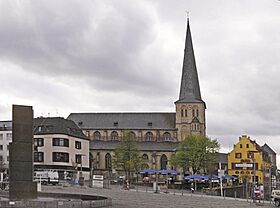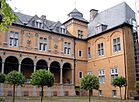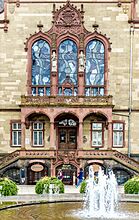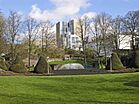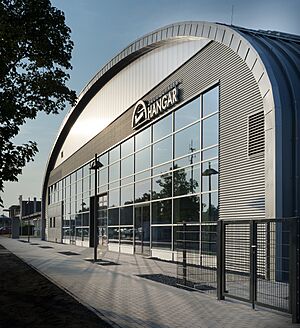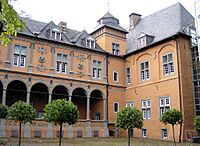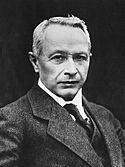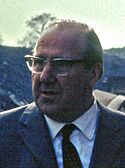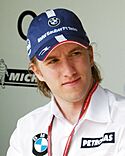Mönchengladbach facts for kids
Quick facts for kids
Mönchengladbach
Jlabbach (Limburgish)
|
|||
|---|---|---|---|
|
Clockwise from top: old market in Gladbach; Schloss Rheydt; Rheydt townhall; Gladbach Abbey; Abteiberg Museum
|
|||
|
|||
| Country | Germany | ||
| State | North Rhine-Westphalia | ||
| Admin. region | Düsseldorf | ||
| District | Urban district | ||
| Elevation | 70 m (230 ft) | ||
| Population
(2022-12-31)
|
|||
| • Total | 268,465 | ||
| Time zone | CET/CEST (UTC+1/+2) | ||
| Postal codes |
41001–41239
|
||
| Dialling codes | 02161, 02166 | ||
| Vehicle registration | MG | ||
| Website | www.moenchengladbach.de | ||
Mönchengladbach (pronounced "MERN-chen-glad-bach") is a city in North Rhine-Westphalia, Germany. It is located west of the Rhine river. The city is about halfway between Düsseldorf and the border with the Netherlands.
Contents
- Exploring Mönchengladbach's Geography
- The History of Mönchengladbach
- Mönchengladbach's Climate
- Mönchengladbach's Economy
- Places to Visit in Mönchengladbach
- Mönchengladbach's Sister Cities
- Getting Around Mönchengladbach
- Sports in Mönchengladbach
- Famous People from Mönchengladbach
- Images for kids
- See also
Exploring Mönchengladbach's Geography
City Areas and Districts
Since 2009, Mönchengladbach has been divided into four main areas called boroughs. These boroughs are then split into 44 smaller parts called districts.
Here are the boroughs and some of their districts:
- Nord: Am Wasserturm, Dahl, Eicken, Gladbach, Hardt-Mitte, Hardter Wald, Ohler, Venn, Waldhausen, Westend, Windberg
- Ost: Bettrath-Hoven, Bungt, Flughafen, Giesenkirchen-Mitte, Giesenkirchen-Nord, Hardterbroich-Pesch, Lürrip, Neuwerk-Mitte, Schelsen, Uedding
- Süd: Bonnenbroich-Geneicken, Geistenbeck, Grenzland-Stadion, Heyden, Hockstein, Mülfort, Odenkirchen-Mitte, Odenkirchen-West, Pongs, Rheydt, Sasserath, Schloss Rheydt, Schmölderpark, Schrievers
- West: Hauptquartier, Hehn, Holt, Rheindahlen-Land, Rheindahlen-Mitte, Wanlo, Wickrath-Mitte, Wickrath-West, Wickrathberg
The History of Mönchengladbach
How Mönchengladbach Got Its Name
The city was first called Gladbach. To tell it apart from another town with the same name, it became München-Gladbach in 1888. "München" means "Monks'" in German, referring to the old abbey.
From 1933 to 1950, the name was written without a hyphen: München Gladbach. People thought this might make it sound like it was part of Munich (which is also "München" in German). So, in 1950, the name changed to Mönchen-Gladbach, and then to Mönchengladbach in 1960.
The town started around Gladbach Abbey in the year 974. It was named after a small brook called Gladbach, which now mostly flows underground. The abbey and nearby villages grew into a town in the 1300s. The town of Rheydt, which is now part of Mönchengladbach, is located close by.
Early Beginnings of the City
People lived in the Mönchengladbach area a very long time ago, about 300,000 to 400,000 years ago. There are also many ancient stone mounds, called cairns, from the Stone Age and Bronze Age.
The city's recorded history began in 974. This is when the Gladbach Minster church was built and an abbey was founded. This was done by Gero, Archbishop of Cologne, and a monk named Sandrad.
To help the town grow, the monks started a market north of the church in the 1100s. Craftspeople came to live and work near the market. Gladbach officially became a town between 1364 and 1366. The town built a stone wall for protection, which citizens had to help maintain. You can still see parts of this old wall today.
In 1794, French forces arrived in the town. In 1801, the area became part of France. This led to the closure of the abbey in 1802. The abbey had a huge library, famous even outside Germany, but its books were lost or destroyed.
Recent Times in Mönchengladbach
In 1815, Gladbach became part of Prussia. It became the main town of the Gladbach district. In 1859, the city of Gladbach and the surrounding rural area split into two parts.
From 1933 to 1975, the nearby area of Rheydt was a separate city. It was later joined back with Mönchengladbach. Because of this, Mönchengladbach is the only city in Germany with two main train stations, both called "Hauptbahnhof" (main station). One is Mönchengladbach Hauptbahnhof, and the other is Rheydt Hauptbahnhof.
In May 1940, during World War II, Mönchengladbach was bombed by the British Royal Air Force. They aimed at roads, intersections, and train lines to stop German troop movements. After the war, in 1946, the city became part of the new state of North Rhine-Westphalia.
| Nationality | Population (31.12 2022) |
|---|---|
| Turkey | 6,614 |
| Poland | 4,538 |
| Syria | 4,027 |
| Romania | 3,266 |
| Bulgaria | 2,872 |
| Ukraine | 2,643 |
| Spain | 2,326 |
| Italy | 1,860 |
| Greece | 1,651 |
| Netherlands | 1,437 |
Mönchengladbach's Climate
| Climate data for Mönchengladbach (1991-2020) | |||||||||||||
|---|---|---|---|---|---|---|---|---|---|---|---|---|---|
| Month | Jan | Feb | Mar | Apr | May | Jun | Jul | Aug | Sep | Oct | Nov | Dec | Year |
| Daily mean °C (°F) | 3.3 (37.9) |
3.8 (38.8) |
6.7 (44.1) |
10.4 (50.7) |
14.2 (57.6) |
17.1 (62.8) |
19.1 (66.4) |
18.6 (65.5) |
15.0 (59.0) |
11.0 (51.8) |
6.9 (44.4) |
4.0 (39.2) |
10.8 (51.5) |
| Average precipitation mm (inches) | 60.8 (2.39) |
57.0 (2.24) |
51.5 (2.03) |
41.1 (1.62) |
58.3 (2.30) |
63.9 (2.52) |
70.9 (2.79) |
72.3 (2.85) |
59.0 (2.32) |
59.9 (2.36) |
60.6 (2.39) |
70.4 (2.77) |
725.7 (28.58) |
| Mean monthly sunshine hours | 54.2 | 73.1 | 125.7 | 174 | 201.6 | 204.4 | 211.3 | 197.3 | 149.3 | 107.5 | 58.8 | 43.6 | 1,600.8 |
| Source: Deutscher Wetterdienst | |||||||||||||
Mönchengladbach's Economy
Mönchengladbach grew as an industrial city because of its textile industry. From the mid-1800s to the mid-1900s, making fabrics and clothes was very important here. Machines for textiles were also made in the city.
After World War II, the city's economy changed a lot. The textile industry became less important. New types of businesses came to Mönchengladbach. Today, only a small number of people work in the textile and clothing industry.
To help the city's economy grow in new ways, the Mönchengladbach Business Development Corporation (WFMG) was started in 1997. They work with the University of Applied Sciences Niederrhein. Together, they have a plan for the city's future economy. This plan focuses on five main areas:
- Textiles and fashion
- Machine and electrical engineering
- Logistics (moving goods)
- Creative industries (like design and media)
- Health care
The biggest employer in Mönchengladbach is Santander Consumer Bank. It has its main office in the city center.
Other important industries include making tools and spinning machines. Companies here also make automatic conveyor systems, signal technology, transformers, and cables. Printed materials and food products are also made in Mönchengladbach.
The chocolatier Heinemann is famous for its cakes and chocolates. You can find their cafés in Mönchengladbach, Düsseldorf, and Munich. The city also has breweries. The Oettinger brewery makes beer where the old Hannen brewery used to be. The Hensen brewery makes a local type of beer called Altbier.
In the 1970s and 1980s, Mönchengladbach was known for its lively nightlife. Now, tourism is becoming more important. The city has about 40 hotels and inns, plus a youth hostel. Over 200,000 people stay overnight in the city each year.
Mönchengladbach Airport is mainly used for smaller planes and private flights. There are no regular passenger flights from this airport. However, Düsseldorf Airport, a major international airport, is only about 20 kilometers (12 miles) away. In 2015, the Hugo Junkers Hangar opened at the airport. It's a place for aviation events. Airplane fans can even book flights on a Junkers Ju 52 plane from the 1940s.
Places to Visit in Mönchengladbach
- Abteiberg Museum: A museum for modern art.
- Schloss Rheydt: A museum about fine art, located in a castle.
- Museum im Wasserturm Rheindahlen: Shows items from the Stone Age.
- Museum Altes Zeughaus e. V.: A museum about Carnival celebrations.
- Schloss Wickrath: A museum about birds, located in a castle.
- Bunter Garten: A city park with a botanical garden and an arboretum (a collection of trees).
- Wasserturm Mönchengladbach: A historic water tower.
Mönchengladbach's Sister Cities
Mönchengladbach has special connections with other cities around the world. These are called twin towns or sister cities:
Getting Around Mönchengladbach
The city has two main railway stations: Mönchengladbach Hauptbahnhof and Rheydt Hauptbahnhof. This is because the two cities merged, and the old name for Rheydt's station was kept.
The S8 train line connects Mönchengladbach to Düsseldorf and Hagen. There are also several regional trains that serve the city. One regional line, RE13, goes to Venlo in the Netherlands.
For local travel, buses and trains are run by NEW-AG. They follow the rules of the VRR transport system.
Sports in Mönchengladbach
Football in Mönchengladbach
Mönchengladbach has a strong history in football. Its home team, Borussia Mönchengladbach, is one of Germany's most famous and successful clubs. They play at the Borussia-Park stadium, which can hold over 54,000 fans. The club's fans are known as "The Foals" (Die Fohlen). It is one of the largest fan clubs in Germany.
Field Hockey Events
The city has hosted three big international field hockey championships. These include the Men's World Hockey Cup in 2006, and the Women's and Men's Hockey Champions Trophy events in 2008 and 2010.
Harness Racing Track
Since 1892, Mönchengladbach has had a harness racing track. It is called Trabrennbahn Mönchengladbach.
Famous People from Mönchengladbach
Many interesting people were born or lived in Mönchengladbach:
- Jacob Masen (1606–1681), a Jesuit priest, historian, and writer.
- Hugo Junkers (1859–1935), an engineer and business owner, known for airplanes.
- Joseph Goebbels (1897–1945), a politician who was Minister of Propaganda in Nazi Germany.
- Lisel Haas (1898–1989), a photographer.
- Hans Jonas (1903–1993), a philosopher who wrote about ethics.
- Franz Meyers (1908–2002), a politician who was a former minister-president of North Rhine-Westphalia.
- Elisabeth Gottschalk (1912–1989), a German-born Dutch geographer and professor.
- Jack Zunz (1923–2018), an engineer who helped design the Sydney Opera House.
- Dietrich Nummert (1928–2021), a journalist.
- Petra Schürmann (1933–2010), who was Miss Germany and Miss World in 1956.
- Hildegard Uhrmacher (born 1939), an opera singer.
- Peter Klusen (born 1951), a writer, translator, and cartoonist.
- Reinhold Ewald (born 1956), a physicist and astronaut.
- Walter Moers (born 1957), an author.
- Joscho Stephan (born 1979), a gypsy jazz guitarist.
- Joko Winterscheidt (born 1979), a television presenter.
- Shakuntala Banerjee (born 1973), a television presenter.
Sports Personalities
- Joseph Pilates (1883–1967), a physical trainer who created the Pilates exercise method.
- Hans Heyer (born 1943), a racing driver.
- Horst-Dieter Höttges (born 1943), a footballer.
- Günter Netzer (born 1944), a footballer.
- Jupp Heynckes (born 1945), a footballer and manager.
- Erwin Kremers (born 1949), a footballer.
- Ulrike von der Groeben (born 1957), a television sports journalist.
- Michael Frontzeck (born 1964), a footballer.
- Ellen Lohr (born 1965), a racing driver.
- Heinz-Harald Frentzen (born 1967), a Formula One driver.
- Jorg Albertz (born 1971), a footballer.
- Nick Heidfeld (born 1977), a Formula One driver.
- Sven Heidfeld (born 1978), a racing driver.
- Marcell Jansen (born 1985), a footballer.
- Isabell Herlovsen (born 1988), a Norwegian footballer.
- Marc-André ter Stegen (born 1992), a footballer.
Images for kids
See also
 In Spanish: Mönchengladbach para niños
In Spanish: Mönchengladbach para niños


